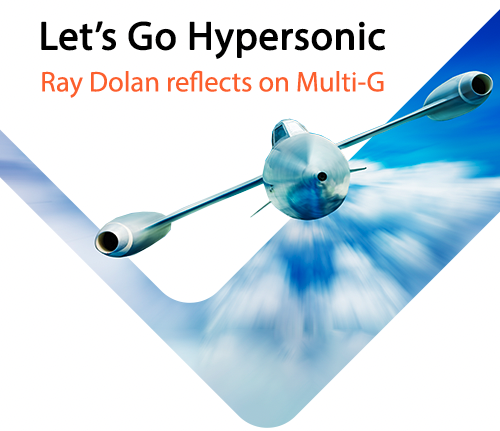A Cloud-based Multi-G OTFS Platform Can Handle Faster Communications and Is More Flexible
As the cellular industry gathers in Barcelona for MWC 2023, it once again finds itself with decisions to make. 5G networks are now proliferating around the globe, even though the anticipated uplift in revenue has yet to be realized. Attention is already turning to 6G—what future fast-speed 6G services will look like and how they could unlock new revenue streams for carriers.
One compelling vision for 6G is new supersonic to hypersonic services that can maintain robust communications regardless of frequency. This can mean connecting satellites in orbit travelling at 20,000 MPH to connect subscribers in remote areas. It can mean managing fleets of fast- moving vehicles on the ground and in the air. And it unlocks new verticals such as the global defense industry—as well as accelerating enterprise use cases such as industrial automation and remote medicine. This will ultimately lead to significant and sustainable revenue growth for carriers.
This is possible, but we need a new waveform that embraces cloud networking.
OFDM was the waveform selected for 4G LTE more than 15 years ago. It offered superior performance and economics, while also providing the granularity to allow IP traffic to flow smoothly over cellular networks. This was demonstrated by Flarion Technologies as early as 2001 (acquired by QUALCOMM in 2006). Up until this point, carriers deploying 3G had to make do with the same “all you can eat” voice revenues despite spending billions for new 3G spectrum and billions more deploying new 3G networks. This is why 3G had the shortest lifespan of any cellular generation—it fell short generating new revenue streams. Almost overnight, 4G ushered in the era of smartphones as we know today. This delivered carriers the incremental revenues needed to justify continued network investment and contributed to a decade of profitable growth.
Given the success of 4G, 3GPP architects selected OFDM again for 5G, redesigning it with wider channels to support network slicing, ultra-low latency, ultra-high reliability, and other features. But by simply using the same waveform with wider channels, the industry has again found itself in exactly the situation it faced with 3G.
So how will the vision for hypersonic 6G be realized? Enter OTFS. Only OTFS can provide reliable, affordable wireless communications even under extreme doppler—hypersonic flight, for example. Here’s how:
- OTFS doesn’t require a cyclic prefix that causes OFDM performance to break down at high levels of mobility—especially at higher frequencies.
- OTFS can deliver information across a wireless network without distortion. The same information that is transmitted is received despite the impairments that currently affect cellular networks.
- OTFS has the capacity to exploit full time-frequency (TF) diversity as well as the ability to work well in high doppler fast-fading wireless channels. OTFS provides 3-7 dB performance gains in high mobility scenarios. The result is greater spectral efficiency, lower deployment costs, and access to new use cases with incremental revenues.
Here’s the good news. OTFS is ready now. Cohere Technologies pioneered OTFS over the past decade and offered it as an alternative to OFDM in 3GPP in 2015/16. It is time to consider it again as we enter the 6G era. To ease the transition, the underlying Delay/Doppler framework used in OTFS has already delivered on the potential for a seamless coexistence of diverse waveforms.
That’s right—the initial promise of dynamic spectrum sharing that allows operators to bridge 4G and 5G can now be delivered using Cohere’s Universal Spectrum Multiplier (USM). This technology has been demonstrated in multiple trials with carriers, delivering compelling performance and full compatibility across both 4G and 5G, for existing Radio Access Networks (RAN) and Open RAN. Since Cohere created the USM as part of the initially proposed OTFS system many years ago, it naturally supports OTFS (6G) as well.
What does this mean for carriers in 2023? The framework is now in place for a Multi-G, software-based cloud platform that allows waveform innovation at a much, much faster pace. As an industry, we’ve spent years “virtualizing network functions,” and the Open RAN framework is now largely established. The combination of these trends creates possibilities for new interfaces and architectural options, such as moving the scheduler to the cloud or data center. Cloud-based Open RAN performance is constantly improving, and dramatic improvements in power consumption and economics will soon follow.
We look forward to more progress and industry engagement in 2023. The cellular industry has a great opportunity to keep connecting more people and machines, drive the digital economy, and bridge the digital divide. Now is the time to seize that opportunity.
At MWC in Barcelona we will share more about OTFS and our vision for Multi-G, Cloud architecture. Cohere and aerospace giant Lockheed Martin will deliver a joint keynote address on Tuesday, February 28, 2023: “Going Hypersonic – Accelerating Secure Wireless to the Edge”. See more at www.mobileworldlive.com.
See our latest announcements here.
Ray Dolan, Chairman and CEO


